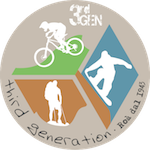A Splitboard is a snowboard that splits in half so as to be able to form two separate pieces and allow snowboarders to climb the snowy slopes with seal skins with a technique similar to that of ski mountaineering. Once you reach the end of the ascent, the two halves are reconnected, forming an integral snowboard with which to practice freeriding.
History of the Splitboard, the snowboard that splits
The history of the Splitboard, the snowboard that splits, begins in the mid-nineties and the documentation known up to now, tells that the first Splitboard originated in the USA from the genius of Brett "Cowboy" Kobernik who invented and patented the Voile, the brand that still today is the leader in the production and sale of Split boards and in the supply of kits also to other snowboard brands interested in the Split market. But digging into the folds of the history of snowboarding, the Skate Snow magazine of 1990 tells the story of the first Italian Splitboard, invented and patented by an engineer from Bologna, mountain enthusiast and snowboard pioneer: Nicolò Manaresi. Nicolò's invention was an old Sims cut in two, precisely split, and reassembled thanks to a handcrafted attachment. The first Splitboard was born, unfortunately the movement wasn't. It has now been 30 years since the invention of the splits and in Europe the Splitboard movement is still immature, while in North America it has been twenty years since the Splits have conquered the market, opening snowboarding to the world of freeride.
What do you need to splitboard?
Splitboarding means practicing an activity that has many points of contact with ski mountaineering and therefore in addition to the specific equipment consisting of a Split snowboard, a kit of adapters for the bindings, climbing skins and crampons for the ascent, it is also necessary to have the indispensable safety equipment consisting of a shovel, Artva, probe and perhaps an avalanche backpack. An equipment that is certainly more expensive, in purely economic terms, than that necessary for snowboarding on the slopes or in snow parks, and for which adequate training is also required: an avalanche self-rescue course, with training on the correct use of the safety equipment , and the ability to understand the snow conditions starting from reading the bulletin of Avalanche (ARPA, Aineva, Ecc...), is absolutely essential before venturing into isolated places, with fresh snow, typically frequented by freeride enthusiasts




